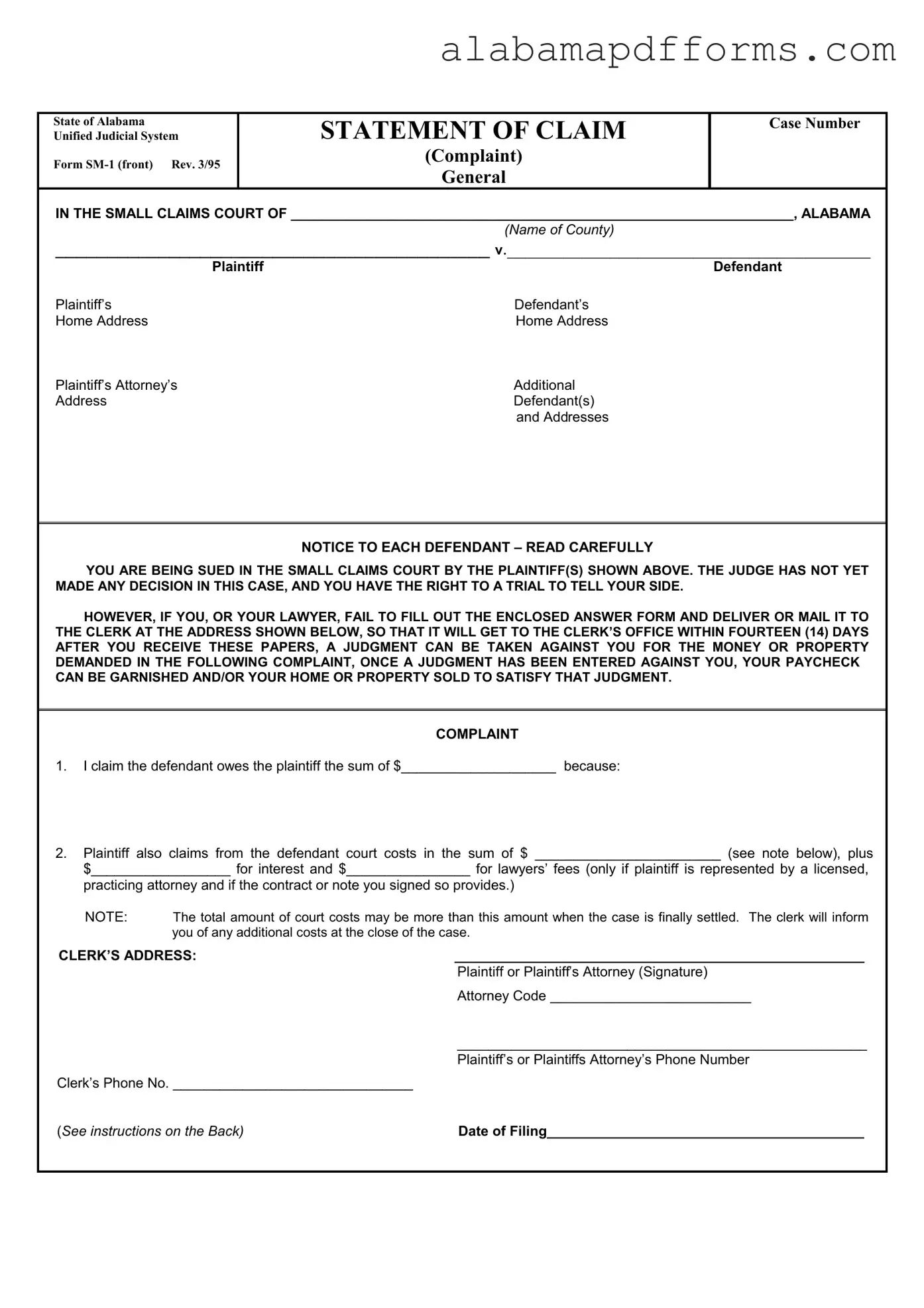State of Alabama |
STATEMENT OF CLAIM |
Case Number |
Unified Judicial System |
|
Form SM-1 (front) Rev. 3/95 |
(Complaint) |
|
General |
|
|
|
IN THE SMALL CLAIMS COURT OF _________________________________________________________________, ALABAMA |
|
(Name of County) |
|
__________________________________________ v._______________________________________
Plaintiff |
Defendant |
Plaintiff’s |
Defendant’s |
Home Address |
Home Address |
Plaintiff’s Attorney’s |
Additional |
Address |
Defendant(s) |
|
and Addresses |
|
|
|
NOTICE TO EACH DEFENDANT – READ CAREFULLY |
YOU ARE BEING SUED IN THE SMALL CLAIMS COURT BY THE PLAINTIFF(S) SHOWN ABOVE. THE JUDGE HAS NOT YET MADE ANY DECISION IN THIS CASE, AND YOU HAVE THE RIGHT TO A TRIAL TO TELL YOUR SIDE.
HOWEVER, IF YOU, OR YOUR LAWYER, FAIL TO FILL OUT THE ENCLOSED ANSWER FORM AND DELIVER OR MAIL IT TO THE CLERK AT THE ADDRESS SHOWN BELOW, SO THAT IT WILL GET TO THE CLERK’S OFFICE WITHIN FOURTEEN (14) DAYS AFTER YOU RECEIVE THESE PAPERS, A JUDGMENT CAN BE TAKEN AGAINST YOU FOR THE MONEY OR PROPERTY DEMANDED IN THE FOLLOWING COMPLAINT, ONCE A JUDGMENT HAS BEEN ENTERED AGAINST YOU, YOUR PAYCHECK CAN BE GARNISHED AND/OR YOUR HOME OR PROPERTY SOLD TO SATISFY THAT JUDGMENT.
COMPLAINT
1. I claim the defendant owes the plaintiff the sum of $____________________ because:
2. Plaintiff also claims from the defendant court costs in the sum of $ ________________________ (see note below), plus
$__________________ for interest and $________________ for lawyers’ fees (only if plaintiff is represented by a licensed,
practicing attorney and if the contract or note you signed so provides.)
NOTE: |
The total amount of court costs may be more than this amount when the case is finally settled. The clerk will inform |
|
you of any additional costs at the close of the case. |
CLERK’S ADDRESS: |
_____________________________________________________ |
|
|
Plaintiff or Plaintiff’s Attorney (Signature) |
|
|
Attorney Code __________________________ |
|
|
_____________________________________________________ |
|
|
Plaintiff’s or Plaintiffs Attorney’s Phone Number |
Clerk’s Phone No. _______________________________ |
|
(See instructions on the Back) |
Date of Filing_________________________________________ |
Form SM-1 (back) Rev. 3/95
INSTRUCTIONS TO THE PLAINTIFF’S
This is your case, and if you are acting as your own lawyer, you are responsible in seeing that your claim is successfully presented at each stage of the procedure until it is concluded.
1.You must complete one of these forms for each defendant you wish to sue. Each defendant must be described by his/her correct legal name and address (not a post office box). Be as brief as possible but include every important name, date and place
2.To start your case you must file the completed form with the clerk assigned to Small Claims cases. The clerk will stamp a copy for you to show that the case has been filed and will insert the number of the case on the front of this form.
3.You are responsible for seeing that each defendant receives a copy of this form. If you haven’t heard from anyone about the case in about fourteen days, then check with the clerk’s office, to make sure that each defendant has been served.
4.If any of the defendants ask for a trial you will be notified of the place, the date, and the time. You must be present or your case will be dismissed. You may take a judgment by default fourteen (14) days after the defendant has received a copy of this form, if the defendant fails to file his/her Answer.
5.You are responsible to see to the enforcement of any judgment that is awarded to you. It is not the responsibility of the court or the clerk to collect the judgment for you.
ANY TIME YOU CONTACT THE CLERK ABOUT THIS CASE YOU MUST REFER TO THE CASE NUMBER ON THE FRONT.
INSTRUCTIONS TO SHERIFF OR PROCESS SERVER
To Any Sheriff or Any Person Authorized by Rule 4.1(b)(1) or 4.1(b)(2) of the Alabama Rules of Civil Procedure to Effect Service in the State of Alabama.
You are hereby commanded to serve this summons and a copy of the Statement of Claim in this action upon the defendant(s) named __________________________________________________________________________________________________
________________________________________________________________________________________________________
and make proper return to this court.
Date ________________________ |
_____________________________________ By__________ |
|
Clerk |
RETURN ON SERVICE:
Served on defendant(s) named _______________________________________________________________________________
________________________________________________________________________________________________________
by delivering a copy of the Summons and Statement of Claim to him/her in ____________________________________________
County, Alabama, on (Date) ______________________________________________________________________,
____________________________________________________
Process Server Signature
____________________________________________________
Title of Process Server
This service by certified mail of this Summons and Statement of Claim is initiated upon the request of _______________________
______________________________ pursuant to Rule 4.1.(c) of the Alabama Rules of Civil Procedure.
Date Requested ___________________________________ |
Date Mailed __________________________________________ |
Return Receipt Date _______________________________ |
______________________________ By___________________ |
|
Clerk |


